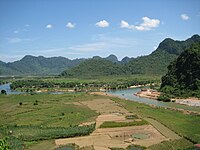
Photo from wikipedia
Abstract Ecotourism can be defined as an environmental activity that takes place in well-preserved areas for recreation and with the responsibility of promoting their conservation. Nowadays, ecotourism is seen as… Click to show full abstract
Abstract Ecotourism can be defined as an environmental activity that takes place in well-preserved areas for recreation and with the responsibility of promoting their conservation. Nowadays, ecotourism is seen as a friendly pastime, but it can potentially affect negatively community diversity and structure by a number of processes such as soil compaction, erosion, and habitat alteration, among many others. Nonetheless, there is hardly any information on the impact of ecotourism in the Tropical Dry Forests and protected areas of the Neotropical region. In an attempt to fill this knowledge gap, the effect of ecotourism was evaluated in a study of a Tropical Dry Forest in the Tayrona National Natural Park of Colombia using dung beetles as bioindicators. A large-scale sampling of three sites with different levels of tourism intensity (no tourism – NT, low tourism – LT, and high tourism – HT) was performed using pitfall tramps baited with human/pig dung during two climatic seasons (rainy and dry). A total of 3238 individuals belonging to nine genera and 15 species were collected. Significant differences in abundances, richness, and the Shannon Wiener diversity index were observed between areas with tourism and those without. These differences disappeared during the dry season in response to the strong reduction in species abundance and richness associated to that time of year. All areas maintained a homogeneous beetle structure in terms of functional groups present irrelevant of the intensity level of tourism. Beta diversity analysis shows that the dung beetle assemblage has a nested structure, indicating that the pressure exerted by tourism entails the loss of particular species. Our results advocate that it is necessary to implement conservation strategies in order to reduce the negative impact of tourism on the National Park’s biodiversity.
Journal Title: Ecological Indicators
Year Published: 2020
Link to full text (if available)
Share on Social Media: Sign Up to like & get
recommendations!